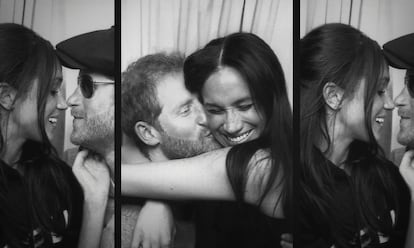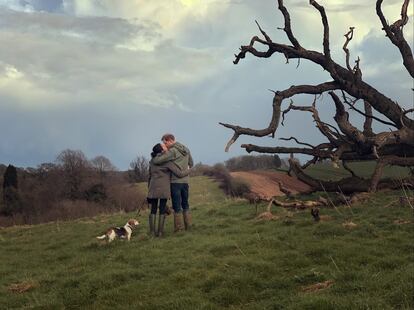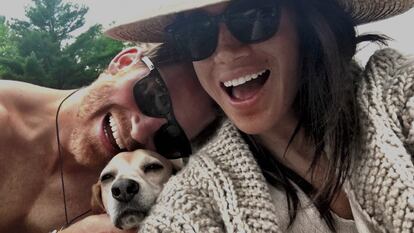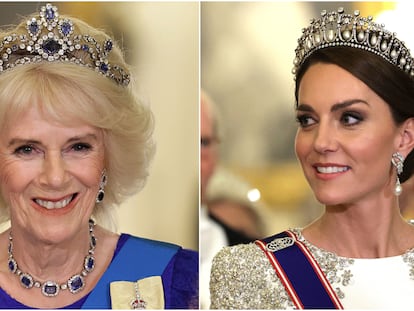‘Harry & Meghan’: When there is nothing left to reveal
With their Netflix docuseries, the Duke and Duchess of Sussex have added little more than a few extra details about the royal family to their well-known narrative. Just what is their endgame?
The story has all the right ingredients to keep audiences on the edge of their seats. It has heroes, villains, centenarian grandmothers, deceased mothers who are revered as saints, glamour, wealth, a culture clash and adorable babies. It even has a plot twist with a bittersweet ending. But when it comes to Prince Harry and Meghan Markle’s fairytale, it is almost impossible to prevent things from getting corny. The schmaltz permeates everything; in fact, it’s precisely what the Duke and Duchess of Sussex appear to be aiming for. This has been the case ever since they left the British royal family two years ago, and it is more on display than ever in their Netflix docuseries, Harry & Meghan.
Their imperfectly perfect love story is at the center of the conversation; anecdotes such as their first encounter, the diamond engagement ring from Botswana and their stolen late-night kisses in the kitchen pave the way for an exploration of their passive-aggressive stance against Britain’s royal family, its tabloid press, British society and the world in general while they themselves emerge as a crusading couple out to defeat the forces that be.
That is the narrative that emerges from the documentary about the Duke and Duchess of Sussex – a title given to them by the late Elizabeth II and which they have no intention of giving up despite calls for them to do so by several Conservative MPs. After much hype, the docuseries has just been released with a target audience of 220 million people around the world, particularly Americans who are seeking a real-life Princess Diaries princess. The details lie in the fact that it is Harry and Meghan disclosing them. Because, really, what more is there to tell that hasn’t already been told? Why tell it again? What role does money play in all this? Is it a question of pride, a test of strength, or simply a way of exposing the Windsors?
Some might consider it a ripping yarn, but it’s not new. Almost everything in it has already been told, no matter what the headlines say – The Daily Mail published 11 news stories on the back of the first 59-second trailer. With each retelling, details are added, but what Henry and Meghan say in front of the Netflix cameras is far from groundbreaking. M and H, as they call each other, claim they want to tell their own story. But they’ve been doing that since they left the royal family. The interview with Oprah Winfrey in April 2021, in which they talked about racism and suicidal thoughts, was such a bombshell that there’s very few lurid details left to be examined. They are, however, details that are worth a $100 million contract with Netflix and which made the first episode of Harry and Meghan the UK’s most viewed program of 2022 on the day of its release, according to the official British audience meter and the BBC; it was watched by more than 2.4 million viewers – 1.5 millio the second day and 800,000 the third; the first episode of the fifth season of The Crown had 1.1 million views on the day Netflix made it available.
The various angles of the couple’s discontent are dissected ad nauseam, such as Harry’s fear that his wife might suffer the same fate as his mother and be relentlessly pursued by the paparazzi. Diana is ever-present in Harry’s narrative, which is logical; but also in Meghan’s to the point that the actress is repeatedly filmed showing her child a picture of Diana and explaining that she is Grandma Diana. Other details that are tirelessly placed under the microscope include the issue of race, despite the contradictions Meghan herself touches upon.

What is novel is the ingenuity of the storytelling, tailored to the fairytale expectations of an American audience. For example, Meghan claims that for her second date with Harry, she arrived from Wimbledon “too dolled up,” and needed to take a shower and change into “something more comfortable.” It was her first formal dinner and the first time she was meeting Harry’s brother and his wife, the Prince and Princess of Wales, and she did so in jeans and, much to her own amusement, barefoot. It is a curious revelation, which is also somewhat trivial, but it is in fact all that is flagged up about the occasion. Then there is Meghan’s professed ignorance of Prince Harry’s identity; she looked him up on Instagram – rather than Google – and found a compilation of landscapes and animals. What she did Google was the British national anthem (despite being an International Relations graduate) and the clothes and hats she might be expected to wear, as no one came to her rescue in this realm. “Do you remember Anne Hathaway’s Princess Diaries?” she says on camera. “There’s no class and no person who says, go sit like this, cross your legs, use this fork, don’t do this, curtsy then, wear this kind of hat.’ Doesn’t happen. So, I needed to learn a lot, including the national anthem. I Googled it and I would sit there and practice and practice and practice,” she says, inviting incredulity. Meghan argues that she was unaware that she was supposed to curtsy to the late Queen Elizabeth II, and recalls the occasion by mimicking her first curtsy to the queen, to Harry’s visible discomfort. Her challenges in this respect may have been real, but to frame them as actual difficulties might raise a few eyebrows, to say the least.
It is Harry and Meghan themselves who have made the story hard to swallow. Although it all began five years ago when they made their engagement public after 16 months of dating, the real drama started in January 2020, when they announced their departure from the British royal family, finalized in March of that same year. At that time, they laid out with absolute clarity their motives for leaving: they longed for a private life away from the Windsors, seeking their own path.
From the moment their relationship became public, Harry complained about the constant media intrusion into their lives, of persecution, deception, bribes and all kinds of tricks to get the scoop on his partner and, later, their children. And he wanted to stop it. “I had to protect my family,” he explains. They were public figures – an obvious target for the press – and they wanted to get out of The Firm to stop their privacy being invaded. But their bid for privacy now seems half-hearted, and their complaints more like the whining of two extremely privileged people.

The documentary is but another example of how Harry and Meghan have learned to capitalize on their woes. The first was the explosive interview they gave to Oprah where they revealed almost everything. Just six months later, they signed a contract with Netflix that The New York Times valued at $100 million, purportedly to create “content that informs but also gives hope,” as explained in their statement. “As new parents, making inspirational family programming is also important to us.” But there haven’t been any inspirational family programs, though Meghan had a children’s project in the works that fell by the wayside. Nor has there been any word on the announced documentary on The Invictus Games, the multi-sport event founded by Harry for wounded war veterans. What has been achieved is an agreement between their production company, Archewell, and Spotify for podcasts about themselves. The first one featured their one-and-a-half-year-old son as a special guest. In the 12 podcasts that Meghan has made, she herself interviews friends and speaks about her own life and experiences. The Duchess has also given interviews to Variety and The Cut, talking openly about the couple’s homes and children.
In fact, the children have emerged as a metaphor for the couple’s story. Their intention was to expose them as little as possible. They presented Archie as a baby in Windsor, swaddled and obscured from the cameras. In the documentary, Archie and Lilibet are initially filmed at a distance with their backs turned. But gradually they move into focus. And all the talk on protecting the family seems vacuous. Something similar happens with the race issue, with Meghan giving mixed versions about how she feels about her environment – how she has been treated in jobs in the US and the UK on account of attitudes towards race.

In a column in the UK magazine The Spectator, its deputy editor, Freddy Gray, claimed that perhaps the couple suffers from something similar to what 19th-century French psychiatrists Charles Lasègue and Jules Falret called folie à deux – a disorder whereby two individuals in close association become co-dependent in a delusional shared system. “In such cases, the shrinks say, a husband and wife can act ‘as a resonator, increasing the pitch of their narcissism,’” writes Gray. “Harry and Meghan aren’t just cynically fishing for empathy in the great lakes of woke America, then. They fully believe themselves to be star-crossed lovers destined to bring down structural racism – a Bonnie and Clyde against the system.”
There are another three episodes that the British press is already describing as “poison” despite not having had access to them. On the one hand, it had better be so: if not, the novelty will be zero and the couple’s credibility irreparably damaged. But if rivers of verbal cyanide do actually flow in the forthcoming episodes, the couple’s relationship with the royal palace, which has so far only spoken unofficially of its disbelief and sadness over the series, may be broken forever. The impact on the palace does not, however, appear to overly concern the couple – note the fragment of Diana’s controversial interview with Panorama in 1995, whose re-broadcast, even in part, Prince William succeeded in getting banned. And still to come is the publication of Harry’s memoir, Spare, to go on sale on January 10. It is hard to imagine what scraps of new information readers can hope to find in its pages.
Tu suscripción se está usando en otro dispositivo
¿Quieres añadir otro usuario a tu suscripción?
Si continúas leyendo en este dispositivo, no se podrá leer en el otro.
FlechaTu suscripción se está usando en otro dispositivo y solo puedes acceder a EL PAÍS desde un dispositivo a la vez.
Si quieres compartir tu cuenta, cambia tu suscripción a la modalidad Premium, así podrás añadir otro usuario. Cada uno accederá con su propia cuenta de email, lo que os permitirá personalizar vuestra experiencia en EL PAÍS.
¿Tienes una suscripción de empresa? Accede aquí para contratar más cuentas.
En el caso de no saber quién está usando tu cuenta, te recomendamos cambiar tu contraseña aquí.
Si decides continuar compartiendo tu cuenta, este mensaje se mostrará en tu dispositivo y en el de la otra persona que está usando tu cuenta de forma indefinida, afectando a tu experiencia de lectura. Puedes consultar aquí los términos y condiciones de la suscripción digital.
More information
Archived In
Últimas noticias
Tiger Woods turns 50: Will he continue playing on the PGA Tour or take a back seat?
The surreal journey of James Nnaji, the Barcelona youth player selected in the NBA Draft who ended up in the NCAA
Trump claims peace in Ukraine is near, but Moscow suggests otherwise
A survivor’s account of the Interoceanic Train accident: ‘We were scared because of the speed on the curve’
Most viewed
- Oona Chaplin: ‘I told James Cameron that I was living in a treehouse and starting a permaculture project with a friend’
- Reinhard Genzel, Nobel laureate in physics: ‘One-minute videos will never give you the truth’
- Why the price of coffee has skyrocketed: from Brazilian plantations to specialty coffee houses
- Pablo Escobar’s hippos: A serious environmental problem, 40 years on
- Chevy Chase, the beloved comedian who was a monster off camera: ‘Not everyone hated him, just the people who’ve worked with him’












































